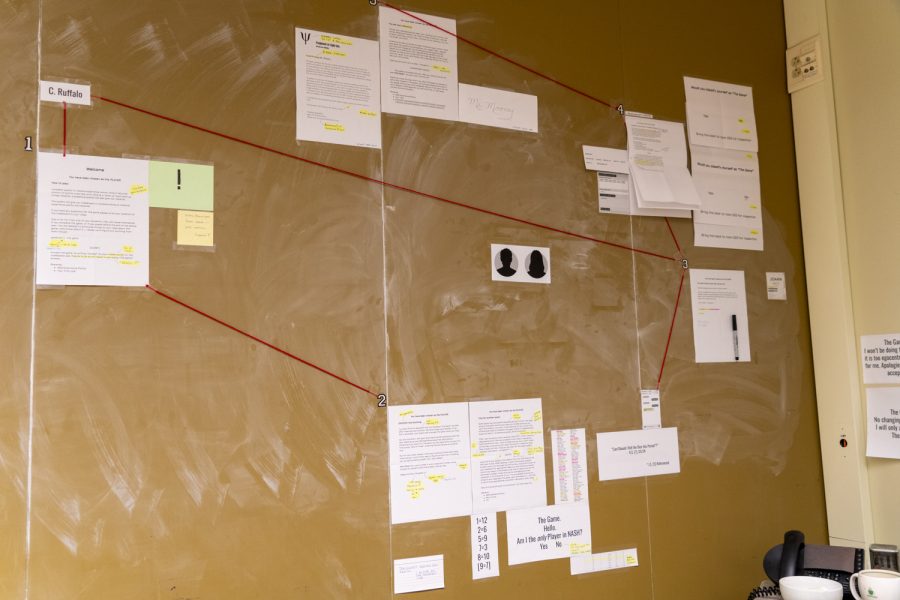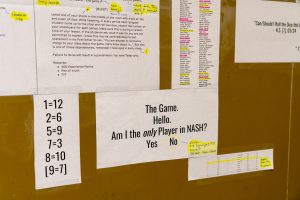The Cracking of the Code
It took NASH English teacher Mr. Mooney months to solve “The Game,” an elaborate string of cryptic instructions and meticulous guesswork orchestrated by a mystery student.
The exciting scavenger hunt known as The Game has wrapped up at NASH.
June 1, 2022
Two months ago, Mr. Mooney’s classroom became the riveting epicenter of a game. The Game. With an elaborate map of clues flourishing on one wall of Room 223 and one loose end after another unraveling, The Uproar last caught up with Mooney before the mystery was solved. But the code has now been cracked, The Game’s creator revealed, and the chase slowed to a satisfying end just as the summer heat hits.
Nate Thomas had the idea for a scavenger hunt around the school in mind since the beginning of his senior year. He always thought Mooney would be a good fit, but it wasn’t until one week in the spring, when Mooney told his classes he was having a hard time, that Thomas decided to implement The Game to cheer up his teacher’s day.
“He seemed like the right person, and I’m very glad I chose him because he loved it,” said Thomas. “He took to it right away.”
The logistics end of the scavenger hunt, which lasted four to five months between initial planning and completion, was extensive. Thomas took great care to remain anonymous. At one point, he created a document labeled “What Mr. Mooney knows” to keep track of Mooney’s progress and avoid any mistakes that would reveal his identity.
The Game required Mooney to perform in-class demonstrations, said Thomas, “which was nerve-wracking because I know he’d be doing it, and I set this up for him, but what if I make the wrong move?”
The clues were originally hidden all around the school, but the tendency of NASH students to rip down posters and mess with any unsecured materials forced him to keep The Game close to Mooney’s room. He sometimes planted clues practically right in front of Mooney, avoiding getting caught every time.
“It was like a minute before we were going to our next period,” recounted Thomas, “and he was talking to some student, and I was right behind him taping something underneath the desk.”
Despite the urge to spill the secret, Thomas recruited no collaborators. But other students joined in anyway, incorporating themselves into The Game as it unfolded. One person posted a fake text message. Another put up a quote from an artist, the same artist whose song Mooney recommended to Thomas just days before; the interference was ultimately what led Mooney to pinpoint Thomas as the orchestrator of The Game.
“A good 20 percent of that board was other people,” said Thomas.
But the sheer number of students Mooney had to rule out led him down plenty of wrong turns. He homed in on Thomas’s best friend because he noticed him circling something on one of The Game’s materials. As he prepared for a dice roll that The Game had instructed him perform, a student came up to him and asked if he could roll the dice; they became another person of interest that threw Mooney off track. While he claimed at the beginning to have narrowed down his list of suspects to ten to fifteen students, he soon had to open it back up to fifty.
Thomas enjoyed watching Mooney solve the puzzle, and seeing it develop on the classroom wall further heightened the fun of it all.
“I loved the wall. I did not think he was gonna do anything like that—I loved just seeing it grow,” said Thomas. “Just seeing it all unfold was really cool because it was nice to see that I was doing something and making him do something that made him happy.”
He recalls denying his role as the gamemaker when Mooney originally confronted him and then returning later the same day to confess. He recalls Mooney telling him about bringing one puzzle-box-type object to Mooney’s brother, who solved it and slammed it onto the kitchen counter in excitement, breaking it. (It was all in good fun, he assured Mooney; the trinket was only worth a few dollars.) He recalls hearing about The Game in gym class and being amazed that it had spread so far throughout the school. Mostly, he recalls the thrill of the whole thing, but also the gratification in creating something with which Mooney and others had fun being involved.
“I enjoyed it; I loved the chase. I just had fun with it. It was supposed to be big, but it really wasn’t supposed to be big. I just really enjoyed it,” he said.
The Game wasn’t Thomas’s first idea for a big project. Sophomore year, he and a few friends planned a social experiment in which they’d mic up a few students and dress them to be unrecognizable, giving them the firsthand experience of the “new kid.” They wanted to observe differences in treatment among students of various genders and appearances, grasping what a new student really goes through. The COVID-19 pandemic disrupted their plans, but Thomas intends to work on similar projects in the future.
As we talked, I kept coming back to the massive effort of the whole thing—the amount of planning and energy that went into making The Game more than just an idea. Many things die in the planning stage, I pointed out, but The Game was different.
“That was my biggest hiccup: Telling myself, ‘Oh, I want to do this,’ but could this get me in trouble, could this…?—that kind of thing,” said Thomas. “But if you really plan it out, think about it, you shouldn’t just keep it as an idea—you should definitely go for it, as long as it’s safe.”
One of the goals of The Game was to push Mooney out of his comfort zone, to get him to commit to something over which he didn’t have complete control (safely and non-threateningly, both Mooney and Thomas assured me). But a parallel goal, Thomas recounted, was to challenge himself.
“It wasn’t just a test for Mr. Mooney—it was a test for me as well,” he said. “I definitely wanted to push myself because Mr. Mooney, at the beginning of the school year, told me I was quiet. He told me I was very quiet. And I wanted to show that I could be loud.”













